初二英语教案 (2)
- 格式:doc
- 大小:101.00 KB
- 文档页数:3

Module 2 My home town and my countryUnit 2 Cambridge is a beautiful city in the east ofEngland.单词south west north home town island area1. To tell the difference among the words: near, opposite, along, on the left/right, across2. To learn some expressions about asking ways and giving directions.3. To learn the reading method.1、能读懂关于介绍剑桥、伦敦、英国的短文,了解文章主旨,并找到相关的细节信息。
2、能够使用所学的语言介绍自己的家乡。
Step 1 Lead-inLet`s enjoy a song and tell what the song is about.Free talk: Have Ss to talk about China.Step 2 Consolidate new words1.Point out the direction words.2.Look and say. The teacher shows the pictures of new words and let the students to say as quickly as possible.Step 3 Look at the map of the England and read these sentences.1. Cambridge is in the east of England.2. London is in the south of England.3. Bristol is in the west of England.4. Manchester is in the north of England.Step 4 Make a dialogue about the directionsLook at the pictures and make dialogues about the cities on the map.Step 5 Point out the directionsLook at the map of China and point out the locations of the following cities.Beijing,Guangdong, Chengdu, ShanghaiStep 6 Read the passageStep 7 Write a passage called My home town. Use Tony’s passage to help you一. 根据所给单词及句子意思,填上适当的短语。
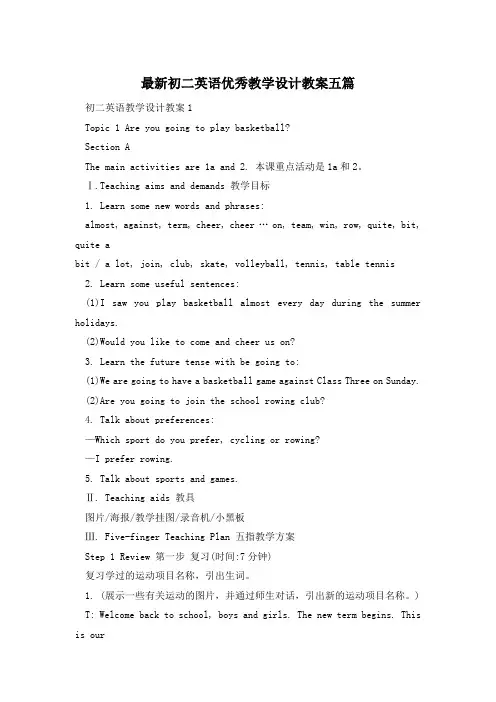
最新初二英语优秀教学设计教案五篇初二英语教学设计教案1Topic 1 Are you going to play basketball?Section AThe main activities are 1a and 2. 本课重点活动是1a和2。
Ⅰ.Teaching aims and demands 教学目标1. Learn some new words and phrases:almost, against, term, cheer, cheer …on, team, win, row, quite, bit, quite abit / a lot, join, club, skate, volleyball, tennis, table tennis2. Learn some useful sentences:(1)I saw you play basketball almost every day during the summer holidays.(2)Would you like to come and cheer us on?3. Learn the future tense with be going to:(1)We are going to have a basketball game against Class Three on Sunday.(2)Are you going to join the school rowing club?4. Talk about preferences:—Which sport do you prefer, cycling or rowing?—I prefer rowing.5. Talk about sports and games.Ⅱ. Teaching aids 教具图片/海报/教学挂图/录音机/小黑板Ⅲ. Five-finger Teaching Plan 五指教学方案Step 1 Review 第一步复习(时间:7分钟)复习学过的运动项目名称,引出生词。
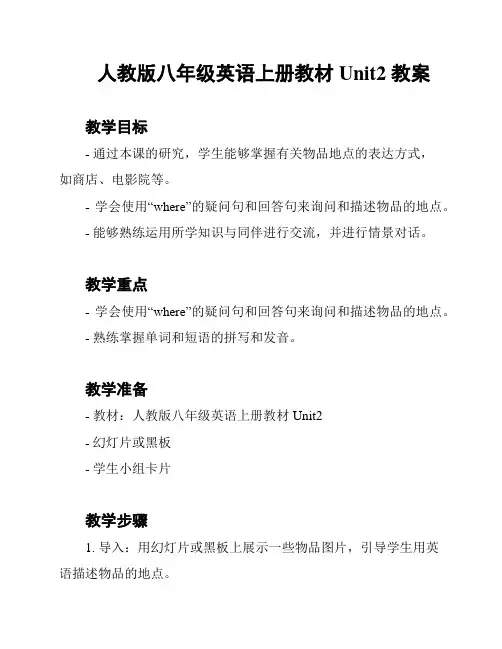
人教版八年级英语上册教材Unit2 教案
教学目标
- 通过本课的研究,学生能够掌握有关物品地点的表达方式,
如商店、电影院等。
- 学会使用“where”的疑问句和回答句来询问和描述物品的地点。
- 能够熟练运用所学知识与同伴进行交流,并进行情景对话。
教学重点
- 学会使用“where”的疑问句和回答句来询问和描述物品的地点。
- 熟练掌握单词和短语的拼写和发音。
教学准备
- 教材:人教版八年级英语上册教材Unit2
- 幻灯片或黑板
- 学生小组卡片
教学步骤
1. 导入:用幻灯片或黑板上展示一些物品图片,引导学生用英
语描述物品的地点。
2. 研究新知:通过教材Unit2的相关内容,教授目标词汇和短语,让学生理解并记忆。
3. 练活动:进行对话练,学生分组,每个小组选择一个物品进行情景对话,询问和回答物品的地点。
4. 拓展活动:让学生运用所学知识,创造自己的对话,交流物品的地点。
5. 归纳总结:让学生回顾所学知识,进行总结归纳。
6. 作业布置:布置课后作业,要求学生练复述本课内容,并使用疑问句和回答句描述物品地点。
教学评价
- 通过学生的课堂表现、练活动和讨论活动来进行评价,检查学生是否能够正确运用所学语言进行物品地点的描述。
- 提供及时的反馈,鼓励学生用英语进行交流。
注意事项
- 确保课堂秩序,引导学生积极参与。
- 注重学生的口语能力培养,鼓励他们进行对话练。
- 提供足够的练机会,让学生熟练掌握所学知识。
以上为人教版八年级英语上册教材Unit2的教案,根据课堂实际情况适当调整教学步骤。
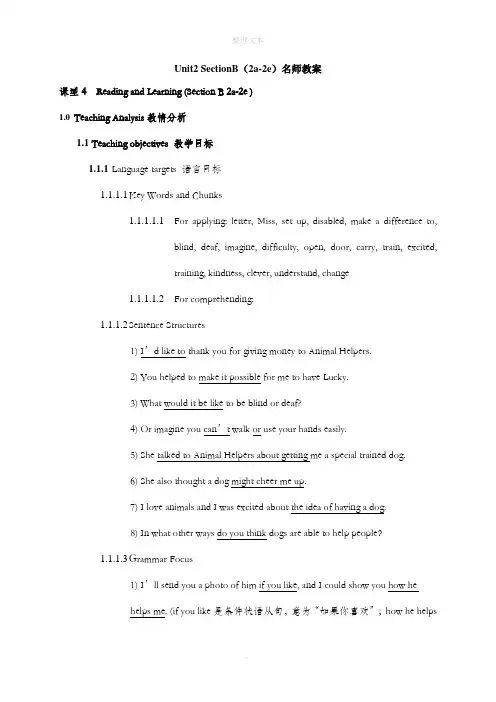
Unit2 SectionB(2a-2e)名师教案课型4 Reading and Learning (Section B 2a-2e )1.0Teaching Analysis教情分析1.1Teaching objectives 教学目标1.1.1Language targets 语言目标1.1.1.1Key Words and Chunks1.1.1.1.1For applying: letter, Miss, set up, disabled, make a difference to,blind, deaf, imagine, difficulty, open, door, carry, train, excited,training, kindness, clever, understand, change1.1.1.1.2For comprehending:1.1.1.2Sentence Structures1) I’d like to thank you for giving money to Animal Helpers.2) You helped to make it possible for me to have Lucky.3) What would it be like to be blind or deaf?4) Or imagine you can’t walk or use your hands easily.5) She talked to Animal Helpers about getting me a special trained dog.6) She also thought a dog might cheer me up.7) I love animals and I was excited about the idea of having a dog.8) In what other ways do you think dogs are able to help people?1.1.1.3Grammar Focus1) I’ll send you a photo of him if you like, and I could show you how hehelps me. (if you like是条件状语从句,意为“如果你喜欢”;how he helpsme是宾语从句,意为“他如何帮助我”)2) I’m su re you know that this group was set up to help disabled people likeme. (was set up是一般过去式的被动语态,一般过去时的被动语态的结构为“was/were+动词过去分词”)1.1.2Ability goals 能力目标1.1.2.1帮助学生通过单词的词性来帮助理解单词在句中的含义。
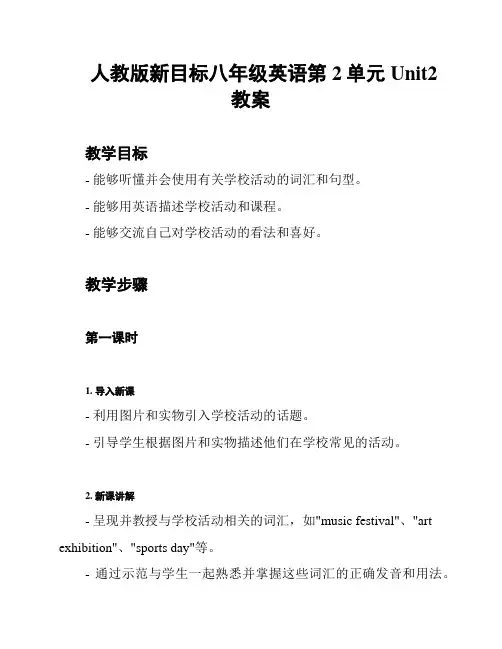
人教版新目标八年级英语第2单元Unit2教案教学目标- 能够听懂并会使用有关学校活动的词汇和句型。
- 能够用英语描述学校活动和课程。
- 能够交流自己对学校活动的看法和喜好。
教学步骤第一课时1. 导入新课- 利用图片和实物引入学校活动的话题。
- 引导学生根据图片和实物描述他们在学校常见的活动。
2. 新课讲解- 呈现并教授与学校活动相关的词汇,如"music festival"、"art exhibition"、"sports day"等。
- 通过示范与学生一起熟悉并掌握这些词汇的正确发音和用法。
- 操练这些词汇,并与学生一起编制句子来描述学校活动。
3. 听力训练- 播放关于学校活动的对话,要求学生仔细听并选择正确的图片。
- 学生互相对话,讨论听到的对话内容。
4. 对话练- 分组或两人一组,让学生模仿对话,表演关于学校活动的场景。
- 鼓励学生用英语进行自由对话,并互相分享自己参与过的学校活动。
5. 作业布置- 课堂分发作业卷,要求学生写一篇短文,介绍自己最喜欢的学校活动,并陈述原因。
第二课时1. 短文分享- 学生轮流与同桌分享自己写的短文。
- 鼓励其他学生提出问题或表达对短文的意见和建议。
2. 阅读训练- 学生阅读一篇关于学校活动的短文,并回答相关问题。
- 教师引导学生理解短文的内容,帮助他们解决阅读中遇到的问题。
3. 语法讲解- 教授句子结构"What do you think of + 学校活动?"和相应的答语。
- 帮助学生理解并掌握这种句子结构的用法。
4. 语法练- 学生分组或两人一组,互相提问"What do you think of + 学校活动?"并回答对方。
- 引导学生用所学词汇和句型互相交流和讨论自己对学校活动的看法和喜好。
5. 总结课堂内容- 教师带领学生回顾本节课所学的词汇、句型和语法。

牛津上海版初二初二下册英语第2讲-时态(2)-1、上次课后巩固作业复习;2、互动探究教学建议:带领学生认真观看这四幅图,并引导学生摸索其中所用时态及其用法,以及比较其中的差异,从而引出本节课要复习的四个时态。
第一幅:过去完成时;第二幅:过去进行时;第三幅:现在完成时;第四幅:现在进行时。
He told me that he had made a serious mistake.When I got to the cinema, the film had been on for ten minutes.3. 过去完成时的时刻状语有:by +过去时刻点(eg. by 2021, by the time he was born) 等。
We had learned 2,000 English words by 2021.My older had worked as an engineer for 2 years by the time I was born.【例题精讲】例1.The bus had gone when I ________ at the bus stop.A.have arrivedB. arrivedC. had arrivedD. am arriving选B,依照句意应该是在我到达公交站之前公交车就走了,过去完成时应该是在一样过去时之前。
例2. Tom ________ of visiting his grandmother, but the bad weather made him change his mind.A. has thoughtB. thoughtC. had thoughtD. had been thought选C,依照句意应该是在Tom改变主义之前想要去拜望他的奶奶,在一样过去时之前应该是过去完成时。
例3.— Did you meet Tom at the airport?— No, he ________ by the time I ________ there.A. has left; gotB. had left; arrivedC. left; arrivedD. left; had got选B,依照句意应该是在我到那儿之前他就离开了,因此“我到达”是一样过去时而“他离开”是过去完成时。
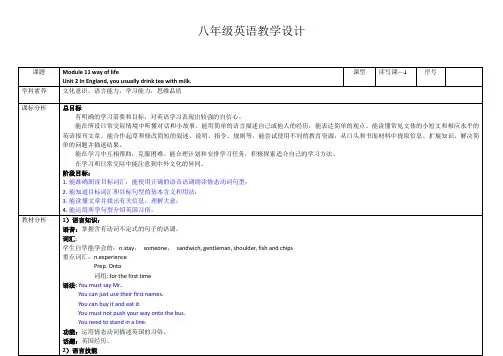

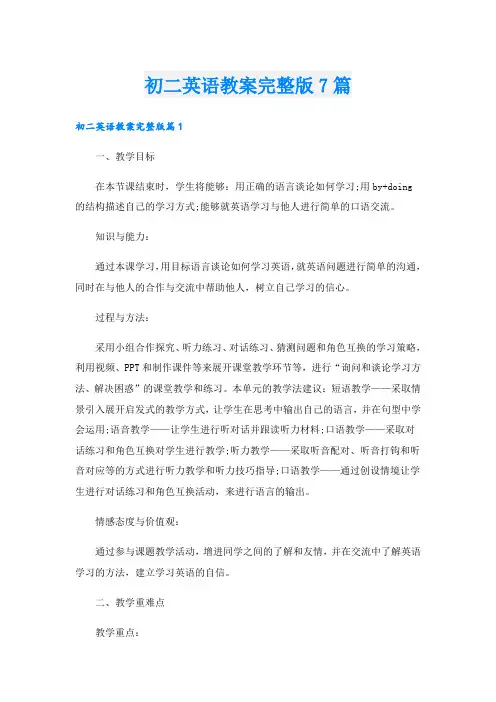
初二英语教案完整版7篇初二英语教案完整版篇1一、教学目标在本节课结束时,学生将能够:用正确的语言谈论如何学习;用by+doing的结构描述自己的学习方式;能够就英语学习与他人进行简单的口语交流。
知识与能力:通过本课学习,用目标语言谈论如何学习英语,就英语问题进行简单的沟通,同时在与他人的合作与交流中帮助他人,树立自己学习的信心。
过程与方法:采用小组合作探究、听力练习、对话练习、猜测问题和角色互换的学习策略,利用视频、PPT和制作课件等来展开课堂教学环节等,进行“询问和谈论学习方法、解决困惑”的课堂教学和练习。
本单元的教学法建议:短语教学——采取情景引入展开启发式的教学方式,让学生在思考中输出自己的语言,并在句型中学会运用;语音教学——让学生进行听对话并跟读听力材料;口语教学——采取对话练习和角色互换对学生进行教学;听力教学——采取听音配对、听音打钩和听音对应等的方式进行听力教学和听力技巧指导;口语教学——通过创设情境让学生进行对话练习和角色互换活动,来进行语言的输出。
情感态度与价值观:通过参与课题教学活动,增进同学之间的了解和友情,并在交流中了解英语学习的方法,建立学习英语的自信。
二、教学重难点教学重点:学习并掌握How do you study...? I study...by ....等相关句型和词汇。
学习并掌握用by + doing 结构表达方式方法。
教学难点:学习并用丰富的语言描述英语学习的方式和方法。
三、教学策略短语教学——采取视频引入话题然后进行启发式教学,并在对话中运用;语音教学——让学生跟读听力材料进行模仿式操练;口语教学——采取pair work 和Role- play问答式的口语交际活动或小组活动互相操练;听力教学——采取采取听音配对、听音打钩和听音对应等方式语法教学——通过模仿听力材料进行对话练习,在教师的纠正中培养正确的by+doing的结构意识。
四、教学过程初二英语教案完整版篇2教学目标:1.会使用可数名词和不可数名词开购物单。

U2 WaterThe first periodTeaching aims:Introduce the topic water. Ask students to work in pairs for a few minutes, and to write down anything they know about water. Ask 3 students to tell their answers and write them down on the black board. Then discuss their ideas briefly and do the exercises. Teaching Important Points :Try to know something about waterTeaching Procedures:1: A Free TalkWhat do you know about water*People can live without food for more than a month, but they can’t live without water for more than week. Losing more than 20% of the normal water content of our bodies will result in a painful death. *About 65-70% of our bodies are water, so it is important for us to drink a lot of water. Each day, a normal person will drink about 2.4 liters of water or other drinks. In America, the average person will use 260 liters of water a day and on average, each person will drink 60, 600 liters of water in his/her life.*Some people believe that our emotions and mental stability are affected when there is a full moon because the gravitational pull of the moon affects the water in our bodies in the same way as it affects the ocean tides. Legends say that werewolves appear when there is a full moon.*You need more water during and after exercise because you lose water by sweating and you need to replace the water that is lost. *Water freezes at 0℃ (32℉). When it freezes, it changes into ice. Water boils at 100℃(212℉) when it changes its form into a gas, becoming steam.2: Look and think* Choose the write answer1 You could live without water for a few ______.a daysb weeksc hours2 Your body needs about ______ liters of water daily.a twob fourc eight3 When you exercise, the amount of water you need _____.a increasesb decreasesc remains the same4 When you freeze water, it becomes a _______.a liquidb solidc gas5 About _______ of the earth is covered by water.a one thirdb one halfc two thirds6 The scientific symbol for water is ________.a H2Ob HO2c H2O2* Use the picture to put these sentences in the correct order. ( ) It flows to the sea.( ) It runs into streams and rivers.( ) It rises from the sea to the sky.( ) Water falls from the clouds as rain.( ) It falls as rain again.Homework:Preview the text: Water talkThe second periodTeaching aims:1 Try to understand the whole lesson and read it fluently. The toneand pronunciation should be basically right.2 Learn the new words and phrases.Teaching aids:Multimedia equipmentTeaching Important Points :How to understand the test completely .Teaching Difficult Points :Teaching Procedures:1: A Free talk(Ask two Ss to talk about some measures we use to save water and say the following.) T: Very good . Thank you for your performance.We have learnt that water is very important and we don’t have enough water in the world. If we don’t have water in our dail y life, the situation will be terrible and we all will die. Some people in other places are suffering from lack of water, such as African people. We should treat every drop of water seriously and should no waster even a drop of water.Show the text on the screen then give brief introduction to the students and then let Ss read the new text after the recording .2: learn some new words.1 brush n. 刷子,毛刷v. 刷,擦,拂拭 We brush our teeth with a toothbrush everyday.2 pour v. 灌注,倾泻,涌入,流,倾盆大雨pour oil on the fire 火上加油Tears poured from her eyes.People poured into he hall.Please pour me a cup of tea.At 5 o’ clock workers pour ed out of the factories.It was pouring.3 sink n. 水槽I left the soap by the side of the sink.v. 使…下沉The ship is sinking.4 vanish v. 消失Forests are vanishing from our land.5 drain n. 排水管Your kitchen drain has become blocked by tea leaves.v. 排去The water drained away slowly.6 freeze v. (使)结冰,凝固The terrible news froze my blood.freezing adj. 极冷的frozen adj. 冻结的 frozen food 7 impatient adj. 不耐烦的,没耐心的 opp.patient 有耐心的I’m getting impatient because I’ve waited for an hour. patience n. 耐心,容忍I have no patience with him again.8 obey v. 服从,顺从,听话They refused to obey (the order).9 faint adj. 微弱的Did you hear the faint moan just now?10 float adj. 漂浮,飘浮Wood floats on water.11 comfortably adv. 舒适的,舒服的comfortable adj. 安乐的,舒适的comfort n. 慰藉,安乐I feel very comfortable in this chair.The lovely baby was a comfort to her.12 view n. 景色,风景The house has a view over the sea.n. 看法,观点What is your view on school punishments?13 speed v. 加速speed upn. 速度at a speed of 80 miles an hour14 nod v. 点头She nodded to show that she agreed with me.n. 点头He greeted me with a nod.15 relax v. 松弛,放松,休息After a day of hard work, I relaxed at home.16 puzzled adj. 困惑的,疑惑的puzzle v. (使)迷惑,(使)为难,迷惑不解n. 难题,迷a crossword puzzleI was puzzled how to do it.Their strange relationship puzzles me.17 treatment n. 治疗,处理His treatment of the animal was cruel.hard treatment: 虐待 be under treatment:在治疗中treat v. 对待,处理18 thorough adj. 完全的,彻底的We’d better have a thorough cleaning to welcome the Chinese New Year.thoroughly adv. 完全地,彻底地We have cleaned the house thoroughly to welcome the Chinese New Year.19 chemical n. 化学制品They added a few chemicals to clean up the water.chemical adj. 化学的 chemical changechemistry n. 化学 She is out chemistry teacher.20 sewage n. 污水We can’t let out sewage because it will pollute the water.21 plant n. 工厂,仪器When the plant closed down, many workers lost their jobs.n. 植物v. 种植22 pump v. 抽水Can you help to pump the water from the well?The heart pumps blood.n. 抽水机,打气筒23 precious adj. 珍贵的,宝贵的Nothing is more precious than friendship.The beautiful vase is very precious.24 weird adj. 怪异的,奇怪的,不可思议的Tom had some weird ideas.3: PracticePlay the tape for students to listen and repeat, then answer some questions.4: Read and thinkComplete the following blanks.1 PETER Why was the voice impatient?JUDY ___________ Daisy was ______________ ______________.2 PETER Why did Daisy nod her head?JUDY ____________ she knew ____ _____ _____ _____ was.3 PETER Why did the water go to a treatment works?JUDY ____________ it _____ _____ _____ _____ journey.4 PETER Why did the water say, ‘I’ll be back in the sea again.’?JUDY ____________ it _____ _____ the sea _____ _____ _____ place.5 PETER Why did the water say it was like liquid gold?JUDY ___________ it believed that _____ _____ _____.6 PETER Why did Benny think his sister was weird?JUDY _________ she said, ‘_____ _____ _____ __________ _____.’ 4: Explain the language Points :1 look around: 向四周看I looked around and found there was no one in the street at all.2 It is /was time to do sth. 是该…的时候了,到…时候了It is time to have lunch. 该吃饭了。

初二英语(人教版)教案Unit-2-How-do-you-come-to-s chool第二单元How do you come to school?一、教法建议二、抛砖引玉单元双基学习目标Ⅰ.词汇学习:moon,sun,ship,another,sea,by,walk,foot,tr ain,fine,clean,eighth,on,foot,by bus,by bike,by car,by train,by plane,by ship,the sun,the moon,fifth,land,usually,air Ⅱ.语法学习:复习、巩固一般现在时态Ⅲ.交际英语:How do you come to school?How many students come by bus?It's a fine day for a walk.Oh.dear!That's right.指点迷津单元重点词汇点拨1.moon月亮,月球The earth is bigger than the moon.地球比月球大。
【点拨】mooncake月饼,moonlight月光,两个都是合成词。
2.sun太阳,阳光The sun rises in the east.太阳从东方升起。
Don't read in the sun.别在阳光下看书。
【点拨】sunrise日出,sunset日落。
该词与moon同,前要加定冠词,因为均是世界上独一无二的。
3.ship船I'm going there by ship.我将乘船去那里。
There are a lot of soldiers on this ship.这艘船上有许多士兵。
【点拨】该词还可作动词表“用船运”。
如:by ship乘船。
They are going ship the machines to Shanghai.他们打算把这些机器用船运往上海。
八年级英语课堂教案八年级英语课堂教案(篇1)学习目标】:1,掌握重点单词的使用及拓展。
2,回顾一般过去时的使用,并能用一般过去时交际和写作。
【学习重点】:一般过去时的写作。
【课前预习】预习Section B,写出下列单词,每个写2遍。
1.活动________________2. 决定_________________3. 尝试____________________4. 鸟_________________5. 自行车 ________________6. 商人_____________________7. 想知道_________________8. 差别___________________9. 顶部______________________10.等候___________________11. 雨伞__________________12. 湿的_____________________13. 在…下面_________________14. 足够的_________________15. 饥饿的_________________16. 鸭子_____________ 17. 不喜欢_________________重点词组:(每个一遍).1. 感受到_______________2. 到达___________________3. 喜欢做某事____________________4. 乘火车_______________5. 第二天__________________6. …顶部________________________7. 因为_________________8. 决定做某事_______________9. 过去________________________10. 走上去___________________11. 太多______________12. 步行________________________13. 忘记做某事______________________14. 发现_____________15. 上升__________________16. 过得愉快________________17. 继续做某事_________________18.到处__________________【合作探究】1.decide 意为:__________, 决定做某事 decide to do sth 决定不做某事decide ______ _____ do sthEg: (1)They decide _________(go) on vacation on Sunday. 他们决定在周日度假。
八年级英语教案八年级英语上册教案优秀8篇教学是一种创造性劳动。
写一份优秀教案是设计者教育思想、智慧、动机、经验、个性和教学艺术性的综合体现。
下面是可爱的小编午夜为大家收集整理的8篇八年级英语教案的相关范文。
八年级英语教学设计篇一一、说教材1、教材内容及地位本节课的主要内容是新目标英语八年级上册第2单元一课时,教材是以What’s the matter ?为中心话题,描述身体不适和提出建议展开,学习和运用“What’s the matter ?”和“What should…do?”让学生学会描述身体的不适和提出建议,本课教材内容与学生的实际生活密切相关,易于引出学生运用简单的英语进行交际和交流,在学习活动中,学生通过交换对身体不适的描述及建议,促进学生之间和师生之间的情感交流,增进情谊。
一课时主要学习的内容是学习有关身体部位的单词,学习“What’s the matter ?”和“What should …do?”句型。
2、说教学目标知识目标:学习掌握有关身体的词汇以及有关疾病的词汇,并学会描述身体的不适和提出建议。
能力目标:听懂本课学习活动中的问题及回答,能在本课的任务型活动中进行简单的交流,能正确朗读本的对和句型,能写出本课的单词和句型。
情感目标:通过描述自己的身体的不适提出建议,表达自己的看法,使学生在人际交往中学会关心别人,增进情谊。
文化意识目标:用恰当的方式表达自己的看法,增进人际交往中学会关心别人的能力,了解英美国家询问和表达身体不适的习惯,培养世界意识。
3、说教学重难点重点:本节课主要学习身体部位的单词和一些疾病的词汇,以及身体不适的表达及建议。
难点:身体不适的表达及建议二、说学情初二年级的学生对英语已经有了一定的基础,但本地区部分学生对学习英语的兴趣不是很浓,在学习中,他们更喜欢从游戏中或活动中学习,这样更能提高他们的学习兴趣,让他们更轻松地掌握英语知识。
三、说教法作为教学的引导着,我遵循新课程“学生是学习的主人,一切的教学活动设计在以学生为本”的教学理念,坚持“为学生的发展,须培养学生的自主性、能动性、独立性和创造性”的教学原则。
Module2 Unit2优质课教案教学目标1. 知识目标:学习掌握本单元出现的新词汇: east, west, south, north, home town, be famous for, countryside和重点短语句子 has a population of;学会并运用表示方位和位置的句型 in the … of …。
2. 能力目标:学习并运用prediction, skimming, scanning等阅读技巧和阅读策略进行阅读训练,提高阅读水平;借助思维导图,分析作者写作方式并补充重庆的基本信息,向外宾介绍自己的家乡。
3. 情感态度目标:通过本节课的学习,比较重庆和英格兰,培养学生热爱家乡,宣传家乡,热爱祖国的美好情感。
East, west, home is the best.4. 文化意识目标:了解英格兰的地理风貌,开阔孩子的视野;通过向外宾介绍自己的家乡来培养学生跨文化交际的能力。
学情分析:本班学生总体英语基础较好,学习兴趣浓厚;而且思维活跃,能积极发言和参与课堂活动。
本单元是Module 2的第二单元,学生刚接触比较级,运用还不熟练;话题是关于英格兰以及两个城市剑桥和伦敦,学生在初一下已经对英国伦敦有所了解,部分学生知识面广,对此话题应该不陌生。
要通过对Tong家乡的分析对比自己的家乡,学生或者列出很多要点,显得散乱,利用思维导图会很好地解决这一问题。
本班共有32位学生,女生只有8位,绝大部分是男生,且区县学生占据绝大部分,地方口音较浓,造成部分同学表达不清晰流利。
重点难点教学重点:学习掌握本单元出现的方位词汇来表示方位和位置。
利用指南针和地图,先从单词到短语,再到句子逐步学习。
教学难点:写一篇欢迎词:欢迎外宾到我校参观并向外宾介绍自己的家乡—重庆。
以文本为参考,利用思维导图,帮助学生理清写作思路并提供重庆的基本信息,降低学生写作难度。
教学过程Step1.Lead in1. Ask student which country they’d like to visit? Then show a short video about Britain to lead in England. Show a map of England and ask students about the location of the places. Students learn to express the location with “in the east/ west/ south/ no rth… of England”.2. Ask students to read the title. Then guess what we’ll learn from the passage. P ut their ideas on the Blackboard to see if their predictions are right.Step2.While-reading1. Skimming for structureStudents read and match the headlines with the paragraphs.Then teacher shows the structures and asks students to choose the right structure of the passage.2. Scanning for details1) Students read Para 1 and Para 2 to complete the chart in Activity 3. Teacher as ks them tocheck the answers by working in pairs to ask and answer about the information of Cambridge and London. Then compare the two cities.2) Students read Para 3 and Para 4 to tell if the statements are true or false with t he evidence in the passage.3. Retelling the passageStudents complete the chart with the information of England and then work in gr oup to retell the whole passage.Then finish activity 4.Step3.Post-reading.1) Discuss if Tony likes his hometown and find the evidences in the passage.2) Compare Chongqing with London with “…than…;as…as…”.3) Learn the saying, “East, west, home is the best.”Step 4. Mind-map1. Analyze the way of Tony’s writing about his hometown.2. Finish drawing the mind-map to introduce our hometown Chongqing.Step 5. Writing1. Tell students Professor Larson and Dr. Murray from MIT will visit our school next week and we’ll give a speech to welcome them and introduce Chongqing to them.2. Students write a speech and then give their speeches in front of the whole class .Step 6. HomeworkAsk students to write a passage to introduce their home town like Activity 6 after class.教学反思本节课的教学内容目标顺利达成。
初中第二课英语人教版教案教材内容:本课内容选自人教版初中英语八年级下册,第二课的主题是“Do you like bananas?”,主要学习水果类词汇和一般疑问句的构成及其回答。
通过本课的学习,学生能够掌握水果类词汇,如apple, banana, cherry, etc.,并能运用一般疑问句询问他人是否喜欢某种水果。
教学目标:1. 能够听懂、说出一系列水果类词汇。
2. 能够正确运用一般疑问句询问他人是否喜欢某种水果,并能用Yes/No或I like/don't like回答。
3. 能够通过情景交际,运用所学词汇和句型进行简单的日常交流。
教学重点与难点:1. 重点:水果类词汇的掌握和运用,一般疑问句的构成及其回答。
2. 难点:一般疑问句的运用和词汇的拓展。
教学准备:1. 教学课件或黑板。
2. 水果实物或图片。
3. 录音机或播放器。
教学过程:Step 1: 导入(5分钟)1. 教师展示一些水果实物或图片,引导学生说出水果的名字。
2. 学生听录音,模仿发音。
Step 2: 新课内容展示(15分钟)1. 教师通过展示水果图片,引导学生学习新词汇,如banana, cherry, etc.。
2. 学生跟读,教师纠正发音。
3. 教师用一般疑问句询问学生是否喜欢某种水果,如"Do you like bananas?",并引导学生用Yes/No或I like/don't like回答。
Step 3: 情景交际(10分钟)1. 教师设置情景,让学生 role-play,运用所学词汇和句型进行日常交流。
2. 学生分组进行练习,教师巡回指导。
Step 4: 课堂巩固(10分钟)1. 教师出一系列水果类词汇的填空题,让学生填空。
2. 学生独立完成,教师批改并给予反馈。
Step 5: 总结与作业(5分钟)1. 教师对本课所学内容进行总结,强调重点。
2. 布置作业:用所学词汇和句型写一篇小作文,描述自己喜欢的水果。
Unit 2How often do you exercise?Language Goal 【语言目标】Talk about how often you do things:in this unit,students learn to talk about what things they do and how often they do these things.KnowledgeGoals 【知识目标】Key Wordshousework,hardly,ever,once twice,full,maybe,least,junk,coffee,health,percent,online,although,through,mind,body,such,together,die,writer,dentist,magazine,however,than,almost,less,point Key Phraseshow often,on weekends,go to the movies,hardly ever,twice a week,three times a week,be good for,at least,such as,less than,morethanKey Sentences1. How often do you exercise?2.What do you usually do on weekends?Key Grammar1. The use of adverbs of frequency.2.“How often” cause of special questions andanswers.Ability Goals 【能力目标】1. Through the learning to gain the ability to talk about how often people do things.2.Write a report about how often people do things.Moral Goals 【情感目标】1. Keep a diary every day.2.Do more exercise and develop good habits to keep healthy.Teaching Time 【课时】Five periodsPeriod 1 Section A(1a-2d)Period 2 Section A(Grammar Focus-3c)Period 3 Section B(1a-1e)Period 4 Section B (2a-2e)Period 5 Section B (3a-Self Check)本单元的教学内容围绕“多久做一次运动”这一话题展开。
初中英语备课教案优秀5篇初中英语备课教案优秀5篇案可以引导教师合理准备和利用教学资源。
在编写教案的过程中,教师需要考虑所需教材、多媒体资料、教具等,确保充分利用各种资源来支持和丰富教学。
下面给大家分享初中英语备课教案,欢迎阅读!初中英语备课教案(精选篇1)【学习目标】1.引导学生学习关于电视节目的常用词汇与句型,掌握mind和stand的用法。
2.通过交流使学生能听懂谈论电视节目的对话;学会用英语简单谈论几种电视节目。
3.引导学生通过开展小组学习活动,培养协作意识;并能学会询问他人对某事物的观点并会正确表达自己的看法。
【学习重点】教会学生用所学的功能语言谈论电视节目。
【学习难点】通过交流表达和听力训练,引入各种学习方法和策略来学习“Whatdo you think of…”Learning action tips:Play the wonderful film clips that students most like to see, guide studentsto talk about the film types and contents they most like to see.Task 1Learning action tips:Previewthe words on Page33-34 in the word list. Students read the wordsby phonetic symbols, then underline new words in the text and mark the Chinese meaning.At last finish thetask in 1a.【Method coach】▲Let s watch a talk show. 让我们看谈话节目吧。
让某人做某事:Let sb. do sth.【导练】( C )Let s ______ for a walk, shall weA.togoB.goingC.go▲stand(1)作不及物动词时,意为“站立”,构成stand up, 反义词为sit down。
Have you ever been to a museum?
一、说教材
三、说教法
四、说教学程序
1.教学思路设计及其依据
(1)教学思路设计
课前导入——分组讨论——图片展示并讨论——快速阅读——精读课文——巩固练习——课后总结——布置作业
(2)依据
①遵循学生认识活动的特点及规律;
②以教师为主导,学生为主体的方式
3.板书设计
(1)思维导图
food history language
↖↑↗
people← Travel →weather
↙↘
position transportation
(2)板书
position: in Southeast Asia
↗
Para1.→population: more than 3/4 of the population are Chinese
↘
language: Putonghua and English
Para.2→food: Chinese/Indian/Western/Japanese food
Para.3→zoo: Night Safari
Para.4→weather: almost the same all year round
4.教学效果
本课以素质教育为目的,结合教材文章中的重难点,利用多媒体教学,从听说读写方面使学生得到锻炼,不仅让学生掌握了教学大纲中的知识点,还帮助学生通过对文章脉络的把握了解英语写作思路,使学生们学以致用。